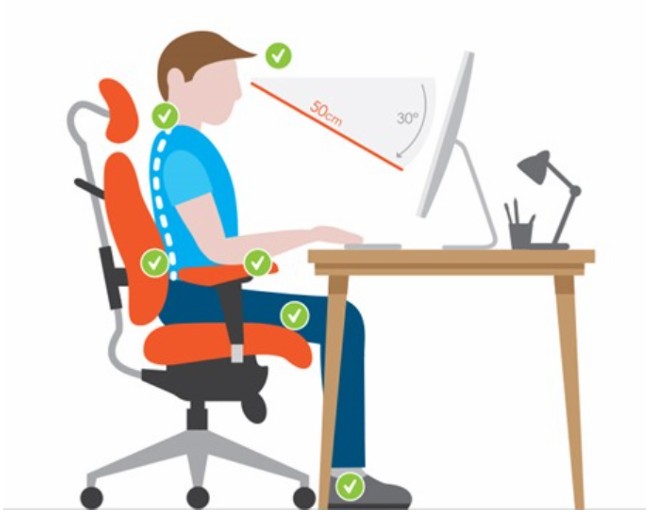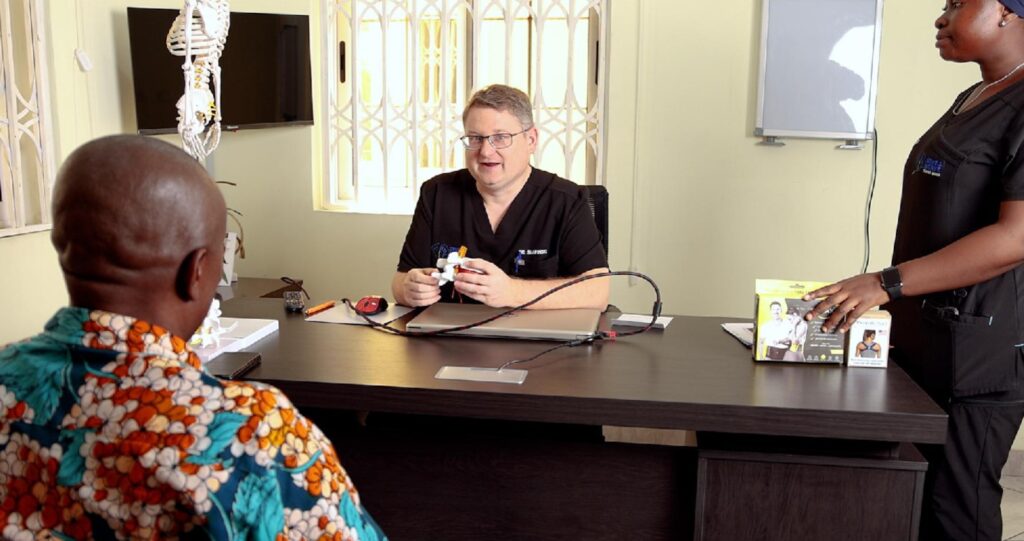With remote work becoming the norm, many of us are discovering an unwelcome side effect: persistent back pain. Long hours spent at kitchen tables, couches, or poorly designed desks can take a serious toll on your spine. Poor posture, lack of lumbar support, and improper screen height are often to blame.
The good news is that these issues are completely fixable. At Spine and Nerve Center Ghana, we are committed to helping you set up a home office that supports your spine, boosts your comfort, and promotes better overall health. With just a few smart adjustments, you can reduce strain, improve
posture, and prevent long-term spinal issues while working from home. Let us guide you in creating a workspace that works for you and your back.

1. Pick the Perfect Chair and Desk
Creating a spine-friendly workspace starts with choosing the right chair and desk. An ergonomic chair is your best friend when it comes to comfort and support throughout the day. Look for a chair that offers firm lumbar support to maintain the natural curve of your lower spine.
If your chair doesn’t have built-in lumbar support, you can easily add a small cushion or rolled-up towel to support your lower back.
Make sure your chair is adjusted to a height that allows your feet to rest flat on the floor, with your knees bent at about a 90-degree angle. This positioning helps promote proper circulation and reduces strain on your lower back and legs.
When you’re typing or using a mouse, your forearms should be parallel to the floor and your wrists relaxed, not bent upward or downward. This helps reduce the risk of developing wrist or shoulder
tension from long hours at your desk.
Your desk also plays an important role. It should be sturdy, stable, and at a height that complements your seated posture. A desk that’s too high or too low can lead to unnecessary hunching or reaching, both of
which put added stress on your spine. Investing time in setting up your chair and desk properly can significantly improve your comfort and help protect your spine in the long run.
2. Screen Time, But Make It Spine-Friendly
Spending long hours in front of a screen? Make it easier on your spine by adjusting your setup to support proper posture. Start by raising your screen to eye level to prevent the common forward neck
crane, which can strain your neck and shoulders over time.
If you’re using a laptop, use a laptop stand along with an external keyboard and mouse. This combination helps you maintain a neutral spine and a relaxed shoulder position, making your workspace more
comfortable and spine-friendly.
Your monitor should be positioned at an arm’s length away, with the top of the screen at or just below eye level. This setup helps reduce eye strain and encourages you to sit up straight, improving your posture and preventing unnecessary discomfort during screen time.

3. Posture Check!
Picture a string gently lifting you from the top of your head, helping you sit taller and align your spine. This is the foundation of great posture. Keep your back straight, shoulders relaxed (not hunched), and feet flat on the floor. Proper posture not only supports spinal health but can also improve breathing and reduce fatigue
throughout the day.
If your chair doesn’t offer proper lumbar support, try rolling up a small towel or cushion and placing it behind your lower back. It’s a simple, effective DIY fix to maintain the natural curve of your spine and stay comfortable while you work or relax.
4. Breaks Are Your Best Friend
When it comes to protecting your spine during long hours of work, taking regular breaks is just as
important as having a good chair or desk setup. Sitting for extended periods can lead to stiffness, poor
circulation, and increased pressure on your spine, especially if your posture slips over time. That’s why incorporating movement into your day is essential.
Set a timer to remind yourself to take a short break every 30 to 60 minutes. During these breaks, stand up, move around, and do a few simple stretches. Shoulder rolls, neck rotations, gentle back twists, or
even a short walk around your space can make a big difference. These small movements help relieve muscle tension, improve circulation, and prevent the stiffness that often leads to discomfort or pain.
In addition to physical benefits, taking regular movement breaks can also help you stay mentally fresh and focused throughout the day. Your body wasn’t made to sit still for hours on end, so listen to it. A
few minutes of stretching or walking each hour can go a long way in keeping both your spine and your energy levels in good shape.
5. Tidy Desk, Happy Spine
A cluttered workspace doesn’t just affect your productivity, it can also put unnecessary strain on your spine. When your desk is messy, you may find yourself constantly reaching, twisting, or leaning awkwardly
to grab items, which can lead to muscle tension and discomfort over time.
To keep your spine happy, organize your workspace so that all your essentials like your phone, notepad, pens, and water bottle are within easy arm’s reach. This simple habit helps you maintain better posture
by reducing the need for repetitive, twisting movements that stress your back and shoulders.
A clean and well-arranged desk creates a more comfortable and efficient work environment. Plus, your body will thank you for the reduced strain and improved alignment throughout your workday.

6. Core Strength for the Win
Having a strong core is one of the best ways to protect your spine and prevent back pain. Your core
muscles including your abdominals, lower back, and pelvic muscles act like a natural brace, supporting
your spine and helping you maintain good posture throughout the day.
When these muscles are weak, your spine takes on more strain, which can lead to discomfort or injury over time.
Incorporating core-strengthening exercises into your daily routine can make a significant difference. Moves like planks, bridges, and cat-cow stretches are simple yet effective ways to build core stability and
flexibility. These exercises not only strengthen your muscles but also improve your balance and spinal alignment.
Plus, fitting in these exercises during the day gives you a perfect mini workout break from sitting. Taking just a few minutes to engage your core can boost your energy levels, reduce stiffness, and keep your spine feeling strong and supported. Over time, building a strong core will help you move more comfortably and reduce the risk of chronic back pain.
7. Need Extra Help? We’ve Got Your Back!
If you find that back pain continues to interfere with your daily life despite making ergonomic adjustments and practicing good habits, don’t worry, you’re not alone and help is available. At Spine and Nerve Center Ghana, our dedicated team of specialists is here to support you every step of the way.
We offer personalized non-surgical spinal decompression therapy tailored specifically to your needs. Our approach focuses on gently relieving pressure on your spine to promote healing and reduce pain
without the need for invasive procedures. Through careful assessment and targeted treatment, we work to restore your spinal health, improve mobility, and help you get back to your daily activities.
Whether you’re dealing with chronic pain, recovering from an injury, or seeking a safe alternative to surgery, our experienced professionals are ready to create a treatment plan that fits your lifestyle and goals. Don’t let back pain hold you back. Reach out to us and take the first step toward lasting relief and better spinal health.
Final Thoughts
A spine-friendly home office can boost your productivity and keep back pain at bay. So, straighten up, take those breaks, and get moving! For more tips or to book a consultation, reach out to Spine and Nerve Center Ghana. Let’s make your remote workdays pain-free and productive!





